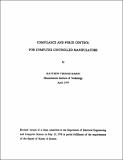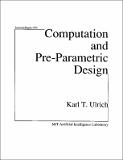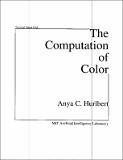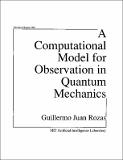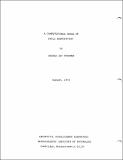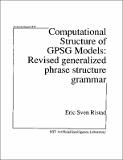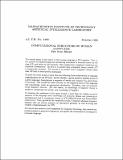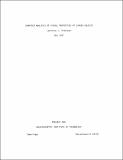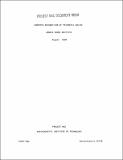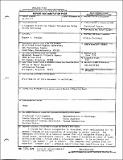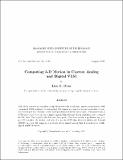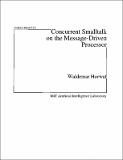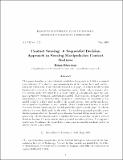Browsing AI Technical Reports (1964 - 2004) by Title
Now showing items 41-60 of 327
-
Combining Associational and Causal Reasoning to Solve Interpretation and Planning Problems
(1988-08-01)This report describes a paradigm for combining associational and causal reasoning to achieve efficient and robust problem-solving behavior. The Generate, Test and Debug (GTD) paradigm generates initial hypotheses using ... -
Compact Representations for Fast Nonrigid Registration of Medical Images
(2003-07-04)We develop efficient techniques for the non-rigid registration of medical images by using representations that adapt to the anatomy found in such images. Images of anatomical structures typically have uniform intensity ... -
A Compilation Strategy for Numerical Programs Based on Partial Evaluation
(1989-02-01)This work demonstrates how partial evaluation can be put to practical use in the domain of high-performance numerical computation. I have developed a technique for performing partial evaluation by using placeholders ... -
Compliance and Force Control for Computer Controlled Manipulators
(1979-04-01)Compliant motion occurs when the manipulator position is constrained by the task geometry. Compliant motion may be produced either by a passive mechanical compliance built in to the manipulator, or by an active ... -
Computation and Pre-Parametric Design
(1988-09-01)My work is broadly concerned with the question "How can designs bessynthesized computationally?" The project deals primarily with mechanical devices and focuses on pre-parametric design: design at the level of detail ... -
The Computation of Color
(1989-09-01)This thesis takes an interdisciplinary approach to the study of color vision, focussing on the phenomenon of color constancy formulated as a computational problem. The primary contributions of the thesis are (1) the ... -
A Computational Model for Observation in Quantum Mechanics
(1987-03-01)A computational model of observation in quantum mechanics is presented. The model provides a clean and simple computational paradigm which can be used to illustrate and possibly explain some of the unintuitive and ... -
A Computational Model of Skill Acquisition
(1973-08-01)This thesis confronts the nature of the process of learning an intellectual skill, the ability to solve problems efficiently in a particular domain of discourse. The investigation is synthetic; a computational performance ... -
Computational Structure of GPSG Models: Revised Generalized Phrase Structure Grammar
(1989-09-01)The primary goal of this report is to demonstrate how considerations from computational complexity theory can inform grammatical theorizing. To this end, generalized phrase structure grammar (GPSG) linguistic theory ... -
Computational Structure of Human Language
(1990-10-01)The central thesis of this report is that human language is NP-complete. That is, the process of comprehending and producing utterances is bounded above by the class NP, and below by NP-hardness. This constructive ... -
Computer Analysis of Visual Properties of Curved Objects
(1971-05-01)A method is presented for the visual analysis of objects by computer. It is particularly well suited for opaque objects with smoothly curved surfaces. The method extracts information about the object's surface properties, ... -
Computer Recognition of Prismatic Solids
(1970-08-01)An investigation is made into the problem of constructing a model of the appearance to an optical input device of scenes consisting of plane-faced geometric solids. The goal is to study algorithms which find the real ... -
Computer Recognition of Three-Dimensional Objects in a Visual Scene
(1968-12-01)Methods are presented (1) to partition or decompose a visual scene into the bodies forming it; (2) to position these bodies in three-dimensional space, by combining two scenes that make a stereoscopic pair; (3) to ... -
Computer System for Visual Recognition Using Active Knowledge
(1976-06-01)A system for visual recognition is described, with implications for the general problem of representation of knowledge to assist control. The immediate objective is a computer system that will recognize objects in a ... -
Computing 3-D Motion in Custom Analog and Digital VLSI
(1994-11-28)This thesis examines a complete design framework for a real-time, autonomous system with specialized VLSI hardware for computing 3-D camera motion. In the proposed architecture, the first step is to determine point ... -
Concurrent Aggregates (CA): An Object-Oriented Language for Fine-Grained Message-Passing Machines
(1990-07-01)Fine-grained parallel machines have the potential for very high speed computation. To program massively-concurrent MIMD machines, programmers need tools for managing complexity. These tools should not restrict program ... -
A Concurrent Smalltalk Compiler for the Message-Driven Processor
(1988-05-01)This thesis describes Optimist, an optimizing compiler for the Concurrent Smalltalk language developed by the Concurrent VLSI Architecture Group. Optimist compiles Concurrent Smalltalk to the assembly language of the ... -
Concurrent Smalltalk on the Message-Driven Processor
(1991-09-01)Concurrent Smalltalk is the primary language used for programming the J- Machine, a MIMD message-passing computer containing thousands of 36-bit processors connected by a very low latency network. This thesis describes ... -
Contact Sensing: A Sequential Decision Approach to Sensing Manipulation Contact
(1995-05-01)This paper describes a new statistical, model-based approach to building a contact state observer. The observer uses measurements of the contact force and position, and prior information about the task encoded in a ... -
Contact Sensors for Dexterous Robotic Hands
(1986-06-01)This thesis examines a tactile sensor and a thermal sensor for use with the Utah-MIT dexterous four fingered hand. Sensory feedback is critical or full utilization of its advanced manipulatory capabilities. The hand ...




